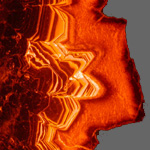

Secondary carbonate in soils and paleosoils as paleoenvironmental proxy
Carbonate can be precipitated during pedogenesis in soils. Forms, formation and accumulation processes of pedogenic (or secondary, authigenic, in situ) carbonate are our aim of study.
According
to the classical pedological ideas, the amount, rate and depth of accumulation
of secondary carbonate can mainly be attributed to climatic conditions
(e.g. a relationship has been proposed between the depth to carbonate
nodular horizon in soils and the mean annual precipitation). Other influencing
factors can be temperature and moisture in the soil and its parent rock,
but due to its close relationship with climate it is convenient to use
pedogenic carbonate as a proxy for paleoclimatic reconstructions.
Nowadays, however, there are opinions saying that the role of biogenic
factors independent from climate are more important in the precipitation
of soil carbonate than thought before. Bacteria, fungi, plants and animals
can have direct or indirect effects in carbonate accumulation beside inorganic
precipitations. Therefore it is essential to elucidate its origin and
age relative to the host soil before using soil carbonate as a paleoenvironmental
proxy.
Studying pedogenic carbonate can provide information about processes and conditions of pedogenesis. In case of fossil soils the paleoenvironment (climate, vegetation) can be reconstructed. Our examinations are concentrated mainly on secondary carbonate phases in soils developed on Quaternary sedimentary rocks (loess, "red clay", travertine), which are widespread in Hungary.
Methods of study
-
macroscopic observations on field, mezoscopic observations by binocular
microscope,
- textural-micromorphological study using polarizing and cathodoluminescence
microscope,
- mineralogy by X-ray powder diffraction,
- stable isotope geochemistry (d13C, d18O),
- morphology by scanning electronmicroscope,
- chemical composition by electronmicroprobe analysis.
Isotope geochemistry of soil carbonates
Determination of stable isotope composition has an essential role in studying soil carbonates. Carbon in soil carbonate can be derived partly from dissolution of primary carbonate (rock fragments, dust), partly from CO2 gas in the soil atmosphere. Sources of soil CO2 are root respiration, microbial oxidation of organic matter (together soil respiration) and CO2 from the atmosphere. The carbon isotope composition of CO2 derived from soil respiration depends on the photosynthetic type of the vegetation covering the soil. The fractionation of carbon isotopes can be different during different photosynthesis pathways, CO2 from respiration of C3 and C4 plants has different carbon isotope composition (C3 type plants: most trees, cold climate grasses - d13Cbulk organic matter = -27‰, C4 type plants: warm climate grasses, corn, sugar-cane - d13Cbulk organic matter = -13‰). If carbon contribution from atmospheric CO2 penetrating into the soil or dissolution of primary carbonate is negligible, the d13Ccarbonate is controlled by the soil respiration, that is the ratio of the C3 and C4 plants. The carbon isotope composition of soil carbonate in case of 100% C3 type vegetation is d13C = -13 to -10‰, in case of C4 type vegetation is d13C = +1 to +4‰ (intermediate d13C values are expected in case of mixed vegetation).
The oxygen isotope composition of soil carbonate depends on several factors, e.g. d18O value, amount and seasonal distribution of rain water, evaporation of soil water, soil temperature.
Applications of stable isotope composition of soil carbonates
- Understanding their formation as a phenomenon. Data can indicate the source of carbon, and can reveal differences in the physico-chemical conditions during formation of distinct carbonate forms.
- Revealing ecological and/or climatic changes in an area. Carbon isotope composition of pedogenic cabonates occurring in (paleo)soil horizons of different ages can record changes in type (sometimes density) of vegetation in time. This is often accompanied by changes in climatic conditions (temperature, precipitation) recorded in d18Ocarbonate values or in geomorphology. The stable isotope data of pedogenic carbonate (combined with the stable isotope analysis of soil organic matter) are suitable for reconstructing the paleoenvironment, therefore can serve basic data for archaeology as well.
- Tracing the role of soils in the global carbon cycle. Pedogenic carbonate participates in the global carbon cycle by withdrawing some carbon from the cycle and storing it. Stable isotope analysis is able to determine more accurately the amount of secondary carbonate in bulk (soil) samples than field observations, binocular or polarizing microscopic studies. This allows determining evolution of (inorganic) carbon storage capacity of soils during the Earth history.
- Determining CO2 content in the past atmosphere. CO2 in the atmosphere had/has an important role in controlling the temperature of Earth surface. Miocene or older paleosol carbonates could record CO2 concentration of the past atmosphere, since C4 plants appeared in the vegetation only in Miocene and atmospheric CO2 could incorporate into paleosoil carbonates beside CO2 from C3 plants.
Our results
See publication list for Bajnóczi B.
The
research is supported by the Hungarian National Fund (D 048631).